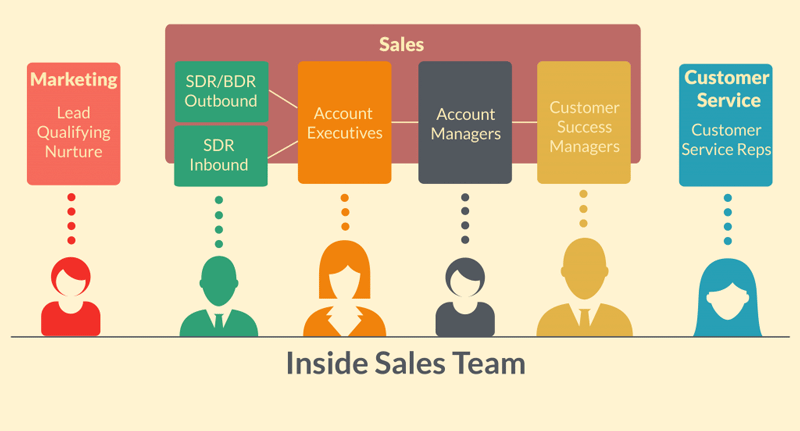In his 1776 magnum opus, The Wealth of Nations, Adam Smith predicted a future where division of labor in manufacturing processes would lead to greater productivity and prosperity. His prediction came true within decades as the Industrial Revolution took hold throughout Europe and America, leading to the creation of highly specialized manufacturing jobs.
A similar phenomenon of hyperspecialization is taking place in knowledge worker fields today. Broad job descriptions (“software developer”) have given way to specialized roles (“web developer”, “mobile developer”, “front-end developer”, etc.). This isn’t unlike Taylorism in industrial manufacturing at the end of the 19th century.
Naturally, this hyperspecialization has affected inside sales teams as well.
Hyperspecialization of Inside Sales Team in B2B Software
As I wrote in my last post, the first inside sales teams set up appointments for field reps. As communication tools improved, some of these inside sales reps started closing small deals over phone and email. Their success led to companies creating small inside sales divisions. These had simple hierarchies – usually a handful of salespeople prospecting, closing and managing deals among themselves with no strict division of responsibilities.
The modern inside sales team is a different beast altogether. For most B2B software companies, the inside sales team is broken up into four or five distinct roles:
1. Sales Development Representative – Inbound Lead Qualification: The chief responsibility of inbound SDRs is to qualify inbound leads and set up appointments for Account Executives. All incoming leads are categorized as “ready to buy” and “not ready to buy, with the former going straight to Account Execs for closing. A well-run B2B software company can receive a large number of inbound leads every day. Speed of response and deep lead qualification, thus, are desirable metrics for measuring inbound SDR performance. Sometimes the inbound lead qualification function is in Marketing, as is Lead Nurturing.
2. Sales Development Representative – Outbound Demand Generation: Outbound SDRs are involved in demand generation, i.e. they find qualified targets where no existing relationship exists and set up meetings or demos with account executives. Outbound SDRs are sometimes grouped by territory or product, but usually have a lot of freedom in how they choose to go about their business. Outbound SDR can be very effective for B2B software startups. As Aaron Ross points out in Predictive Revenue, outbound prospecting was largely responsible for earning Salesforce an additional $100m in revenue.
3. Account Executives: Account Executives are responsible for closing deals. They handle all qualified leads until they turn into paying customers. Because they are responsible for landing a new logo, they are sometimes called “hunters” within sales organizations. You will often see job ads for account executives asking that applicants have a “hunter” mentality.
4. Account Managers (AM) The primary responsibility of Account Managers is to make sure that customers stay with your company. They are also responsible for generating as much revenue from the customer as possible (this includes getting referrals). Because of this, AMs are sometimes also called “farmers”, since they must “farm” customers and extract maximum value from them.
5. Customer Success Managers (CSM): Customer Success Manager (CSM) take a proactive customer service role. The CSM’s job is to make sure that the customer doesn’t churn and for maximizing Customer Lifetime Value. In most sales organizations, they don’t have quotas, nor do they handle renewals and upsells (which is the Account Manager’s job).
What is the Difference Between Customer Success Reps and Customer Support Reps?
If you look at the job descriptions for Customer Success Managers and Customer Support, you might see a few similarities. There is certainly some overlap between the two roles, yet, Customer Support and Customer Success are two different endeavors, each with different end goals.
Historically, B2B technology products required large-scale deployments and heavy investment upfront. This upfront investment “locked in” the customer and the vendors could be reactive in providing support. That is origin of most Customer Support Teams in B2B tech companies. And the primary goal of Customer Support is to respond to a customer identified problem within a given service level.
The concept of Customer Success owes its origin to the growth of SaaS software. With SaaS, customers can spend only a few dollars upfront and test out a service on a monthly basis. Converting such “trial” accounts into long-term, high-value paid accounts and retaining those accounts is a top priority for any inside sales team. The CSMs make sure that customers are getting the most out of the product or service. This isn’t a reactive problem Customer Support can solve. It requires a proactive consultative approach and the holistic overview that Customer Success Managers bring to the table.
In most businesses, CSMs are responsible for a high-level understanding of the customers’ health within a sales organization. For this reason, they seldom carry any quotas; their chief job is to extract maximum value from customers and to make sure they don’t churn. The key metric for them is Customer Lifetime Value, rather than the number of closed tickets handled. CSMs are also responsible for community development and turning customers into cheerleaders, who, in turn, can bring in those 9 and 10 NPS scores and provide referrals.
Customer Support, on the other hand, is responsible for reactive problem solving. These are the people who handle errors, solve technical issues and answer questions. They deal with issues on a case-by-case basis and don’t have the macro view that CSMs have. Their primary job is to solve break-fix problems, not pitch additional products, get referrals, or reduce customer churn.
Think of it this way: Customer Support is reactive and Customer Success is Proactive
It’s may seem like a subtle difference, but it could mean the world in your success.
Mansour Salame
Latest posts by Mansour Salame (see all)
- The Failed Sales Plan - May 20, 2016
- What Percentage of Leads Should You Close? - April 14, 2015
- Anatomy of an Inside Sales Team: The 5 Key Parts - February 25, 2015


